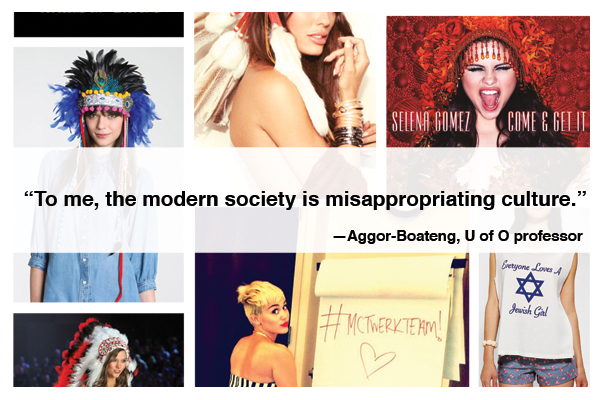Is cultural appropriation ever appropriate?
Photo illustration by Tina Wallace
Miley Cyrus’s new look has caused quite the stir amongst reporters and bloggers, especially after her racey Video Music Awards performance with Robin Thicke. The problem some people have with Cyrus’s adoption of “ratchet” style, and with other pop culture and media phenomena like the Harlem Shake, is that they are negative examples of cultural appropriation—the adoption of minority culture traditions by a dominant culture.
A problem
Research from feminist author and social activist bell hooks suggests the main problem with cultural appropriation is that it completely removes the cultural significance of social traditions of other ethnicities to enhance white culture in Western society.
“The over-riding fear is that cultural, ethnic, and racial differences will be continually commodified and offered up as new dishes to enhance the white palate—that the Other will be eaten, consumed, and forgotten,” she wrote in her essay Eating the Other.
Adolphine Aggor-Boateng, a University of Ottawa professor in the department of sociology and anthropology, said the Western cultural majority’s adoption of cultural elements is done in a way that doesn’t acknowledge the deep meanings associated with the traditions of minority cultures within their original context.
“It is a power issue,” she said. “To me, the modern society is misappropriating culture.”
According to Aggor-Boateng, these “power issues” arise from the inequitable distribution of the opportunities and social outlets available to those who identify themselves as part of a minority group. She said this non-egalitarian relationship between the dominant and subordinate cultures renders the possibility of positive multicultural integration unlikely.
Originally from Ghana, Aggor-Boateng identifies in part with those victimized by this cultural “misappropriation.” In her personal experience, watching those outside her culture wear African cultural garments was not a wholly positive experience; she felt as if the intrinsic meanings she attributed to the adornment of such clothing were not present when worn by those outside of the culture. The sense of pride and individuality she experienced while wearing her cultural dress was entirely lost to outsiders.
In North America, Halloween is the one day of the year that would arguably demonstrate negative cultural appropriation at its most visible. The traditional clothing of many different ethnicities is worn as a costume not to appreciate these cultures, but to aesthetically resemble minority cultures or even to mock them.
Native Appropriations, a blog dedicated to raising awareness around the racially discriminatory practices against people of native origin, featured an article in October on the topic of Halloween that critically analyzes the practices employed by companies in the marketing of costumes. Adrienne Keene, a doctoral student in culture, communities, and education at Harvard University and the author of Native Appropriations, wrote that the search of the keyword “Indian” on a Halloween website garnered 56 costume results.
“These costumes are hurtful and dangerous because they present a false and stereotyped image of Native people,” she wrote. “The public sees these images, and it erases our current existence, so the larger, contemporary issues in Indian Country then cease to exist as well.”
In the media
To understand the debate regarding cultural appropriation in terms of Cyrus’s new “ratchet” fashion style, one must examine the roots of the “ratchet culture” and why her use of the word can be considered offensive in this context.
The website Feministing released an article about the use of the term ratchet by Cyrus and other people of privilege. Author Sesali Bowen said ratchet culture is associated with the “linguistic, stylistic, and cultural practices, witnessed or otherwise, of poor people; specifically poor people of color, and more specifically poor women of color.” However, the term has become one that white people of privilege use freely to describe anything they think fits in that category, without having experienced an actual “ratchet” lifestyle or acknowledging that the term is used to define that specific lifestyle.
“I can’t stress enough that pop culture trends like twerking, ‘Ain’t nobody got time for that,’ or even just using the word ‘ratchet’ to define the wild things that happened at last night’s party are all rooted in someone’s lived experience,” Bowen wrote.
Huffington Post music blogger Anne Theriault agrees that Cyrus’s use of select elements of black culture to define the culture as a whole is offensive. Theriault believes Cyrus has little understanding of the culture she appropriates and does not reflect on her choice of words and actions, and that both are major problems.
“She is playing at being black without even trying to understand what the lived experience of being black really is,” Theriault wrote. “She is appropriating cultural elements without taking any time to reflect on her position of privilege and how her use of the term ‘ratchet’ or her twerking are contributing to the oppression of black people.”
The Harlem Shake video trend has also been debated as inappropriate and an example of the negative effects cultural appropriation can have on culturally significant traditions. Huda Hassan wrote an article for Huffington Post about the Harlem Shake memes.
“The problem at hand with the Harlem Shake meme … is the mere fact that it is a co-opted version of a dance and sound original to, and considered a cultural artifact of, hip-hop (and specifically Harlem),” she wrote. “In fact, the Harlem Shake meme displays nothing similar to the original dance conceived in the late 1980s by Al B even though it uses the same name.”
Hassan argued that the ultimate problem with using the name Harlem Shake to describe a dance that isn’t the original is that the tradition of the Harlem Shake has become lost. She noted that in order to even find the original dance, one must scour the Internet past the thousands of Harlem Shake videos that don’t pay any form of tribute to Al B’s original dance.
“People view it as a trend,” said York University graphic design student Mariah Morales. “They follow it for the sake of following without acknowledging the meanings behind them.”
It can be a good thing
English and communication tutor Joanne McKay believes cultural appropriation by the media only becomes problematic when it’s done in a way that obliterates the original significance of the minority culture. This social phenomenon is not necessarily negative, but may even yield positive results if executed in a manner that is well informed and free of discrimination and biases.
“It enables us to move past tolerance and towards acceptance,” McKay said.
Morales views cultural appropriation positively, since she believes the intermingling and mirroring of cultures ultimately leads to a greater sense of awareness for those members who are not directly a part of a certain group or ethnicity. They’re able to experience cultures apart from their own in a relatively simple and straightforward way.
She also said her personal experience with cultural appropriation was a positive one overall, despite being of Filipino background and therefore of a minority culture in Canada. She recalled her immigration to Canada as a young girl and says her previously discriminatory views were broadened after experiencing the many different cultures characteristic of Canadian society.
Appropriate appropriation
Though cultural appropriation can be negative when approached incorrectly, there are methods that can be used to try to better understand and truly appreciate cultures outside our own.
In an interview with Jezebel, Fordham University law professor Susan Scafidi discussed the appropriate ways in which majority culture can and should go about purchasing aboriginal products or ones inspired by indigenous culture.
“Consider the three S’s: source, significance (or sacredness), and similarity,” she said. “Has the source community either tacitly or directly invited you to share this particular bit of its culture, and does the community as a whole have a history of harmful exploitation? What’s the cultural significance of the item—is it just an everyday object or image, or is it a religious artifact that requires greater respect? And how similar is the appropriated element to the original—a literal knockoff, or just a nod to a colour scheme or silhouette?”
Where Scafidi’s sentiments infer that the right research and respect toward a minority culture’s objects can combat the negative tradition-eclipsing effects of appropriation, Aggor-Boateng believes the issue of cultural appropriation is not one to be resolved through the sole means of acceptance. Rather, there is a greater issue at hand that requires the general population to reconstruct the existing social liaisons so that all cultures are placed on level ground and granted equal status.
hooks wrote that the issue of power and its unequal distribution in society seems to act as a major drawback in finding positive consequences of cultural appropriation.
“Mutual recognition of racism, its impact both on those who are dominated and those who dominate, is the only standpoint that makes possible an encounter between races that is not based on denial and fantasy,” she wrote.
According to hooks, if the majority and minority cultures in Western society aren’t both aware of the negative outcomes of cultural appropriation and all other forms of racism, the positive effects of integration and appreciation of different cultures can’t properly take place.
A more optimistic perspective was voiced by both Morales and McKay, who viewed the possibility of a society with cultural equality as an achievable feat, so long as the traditions and histories of unique cultures are respected and recognized for their full meaning and potential.
Although the issue of cultural appropriation is one that often ignites social unrest and debate, there seems to be an underlying current of hope, one that may be attained through a re-evaluation of cultural imbalances in power and respectful and appreciative attitudes toward the traditions of minority cultures.





